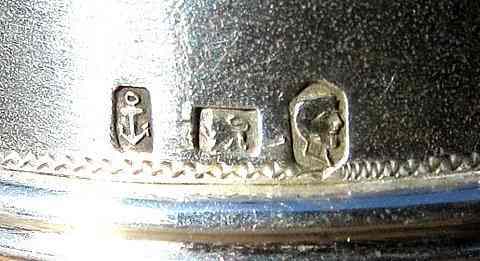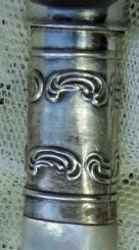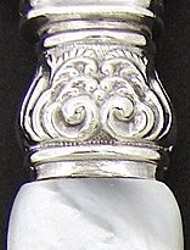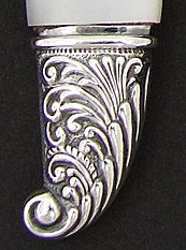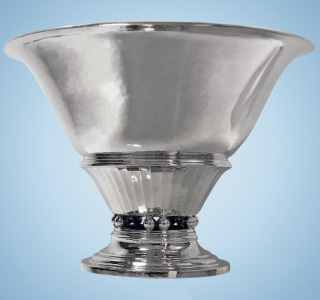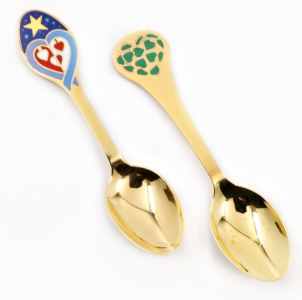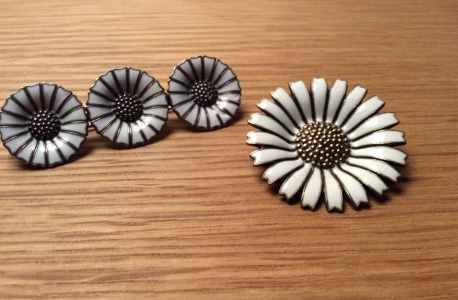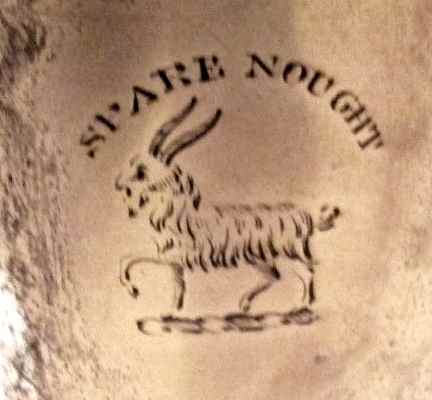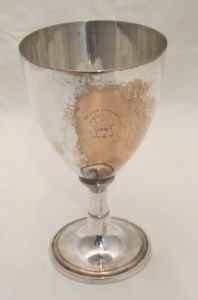
|
|||||
YOUR GUIDE TO NOVEMBER NEWSLETTER:
new members
members' window
mail to ASCAS
replies to questions
a page per month
a silversmith per month
a word per month |


|
University of Newcastle mace (left) and University of New England mace (right)
 |
Flinders University mace
Dear Christine,
thanks for your interesting addition about the work of Gerald Benney.
I publish your information as an "ADDENDUM" in Gerald Benney webpage
Giorgio Busetto
Rubén Sclaroff writes:
... could you help me to identify the hallmarks in this gothic revival style miniature clock?
Thanks in advance
Rubén Sclaroff
In my opinion could be (not sure) the mark of Romania, 1906-1926, 800 silver fineness, see my website at
http://www.silvercollection.it/DICTIONARYEUHALLMARKROMANIA.HTML
The mark on the left would be an unidentified maker
Giorgio Busetto
Andrew J. Brasch writes:
... Dear Giorgio, would you help me who is the Austrian silversmith "IA" on
this set of small bob bon dishes.
The date in the Vienna hallmark is not clear but it looks 1822.
Thank you for your assistance.
Andrew J. Brasch
Possibly the date is 1838. If so, I find only one Viennese maker corresponding to your mark: Apfel Johann
Giorgio Busetto
Anne Yodice writes:
... This is the backstamp of a very fancy sterling silver 8 bottle cruet set. I think I've narrowed it down to 1812 and William Key, compliments of your very informative web site.
Would you know of any book where I could research him?
Thanks for your kind consideration, and most of all, your time.
Anne Yodice
The date is London 1812, the maker is William Kingdon, (St, John Square, Clerkenwell). The mark was registered 9 July 1811. No further information is available about the maker.
Giorgio Busetto
Erica Hernandez writes:
... I stumbled across your website while trying to do research on these spoons. I have not been able to find anything on the hallmarks. I have been searching on a few different informational sites. Maybe they are worth nothing, but was hoping you can add some incite to this matter for me. My Aunt, who collects silver ware, gave me some quite a few mismatch pieces to sell for her. If they are something special,
I would like to have as much information as I can on them before venturing out to place them for sale. Would you be able to help me identify them?
Erica Hernandez
The maker is B. Worth & Sons, Sheffield, see my website at http://www.silvercollection.it/electroplatesilverWZdue.html
Giorgio Busetto
Davide Brusamolino writes:
... I have this icon with Russian silver riza.
I'd wish to have information about the silversmith maker.
Thanks in advance for your help.
.
Davide Brusamolino
The maker is Michael Borodulin, St.Petersburg 1836-1849 (according Geoffrey Watts book).
The assayer could be (Postnikova-Loseva book) Tverskoi Dmitrii Ilbich (St.Petersburg 1832-1850).
Giorgio Busetto
Michelle Chessell writes:
... I have a pair of napkin rings with a "mystery mark" that I'm hoping you can help me solve.
The duty mark bears neither resemblance to the 5 duty marks on British sterling from 1784 to 1890 nor any of the commemorative monarch heads on sterling 1934, 1952 and 1977.
The engraving is in the style of the era mid 1800's to the early 1900's.
There is no makers mark or date stamp and the items do test silver 925.
I will attach photos and I do very much appreciate any help you can offer.
Cheers
Michelle Chessell
Australia
I believe it's a 19th century pseudo hallmark, possibly of an Australian maker.
Giorgio Busetto
"A PAGE per MONTH"
In this column we presents a page obtained from makers'
brochures, books, auction catalogs, advertising or whatever
other printed paper, related to silver, that may be of interest
for ASCAS members.
The images will be published at a "low resolution" level and for
private and personal use only.
This column is published under the kind permission of Giorgio
Busetto's website
SILVER ADVERTISEMENTS
FACTORIES, PLANTS, SALESROOMS, SHOPS AND WORKSHOPS: OLD IMAGES

This month ASCAS presents a trade card and a postcard of a Mexican silver factory
MANUFACTURERA PLAMEX S.A.
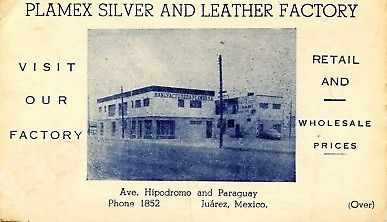
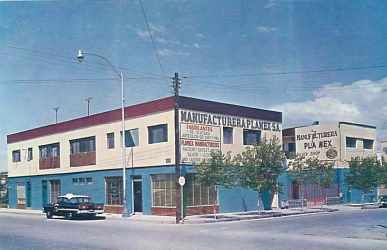
The firm was active at Ave. Hipodromo and Paraguay, Ciudad Juarez, Mexico.
Plamex was specialized in the manufacture of silver and leather items: belt buckles, brooches, cufflinks of typical Mexican design marked 925 sterling and, sometimes, 10K or 18K.

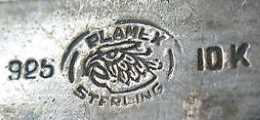
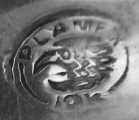



"A WORD per MONTH"
In this column we present an abstract from a page of the "What is? Silver Dictionary"courtesy of
FERRULE (COLLAR) & CAP
Ferrule (or collar) is a small circular metal ring used for fastening mother-of-pearl, ebony, horn or ivorine handles.
Sterling silver and silverplate ferrules were widely used in Victorian period when these types of handles were very fashionable.
Ferrules were often decorated with flowers, shells, swags and other elaborate decorations. Sometimes a small cartouche was available for engraving.
In addition to the ferrule, high quality flatware has a cap to complete the decoration of the handle.....
MORE...
"A SILVERSMITH per MONTH"
In this column
we present marks, information and history of silversmiths and
silver manufacturers.
This column is published under the kind permission of Giorgio
Busetto's website

ANTON MICHELSEN
Anton Michelsen (1809-1877), born in Odense, Denmark, established one of the most important Danish jewelry families. In 1830, after completing his education in Odense, he moved to Copenhagen where, during the next eleven years, he worked for various young masters.
Michelsen acted as a journeyman for Jřrgen Balthasar Dalhoff from 1834-35 while also taking courses at The Royal Danish Academy of Fine Arts. With assistance from Dalhoff, Michelsen received The Travelling Scholarship of the Reisersen Foundation. He then goes to Berlin and during the late 1830's works in several workshops including Mention & Wagner, a large, contemporary silver and gold works whose primary shop is in Paris. While working for Mention & Wagner, he learned enamelling.
In 1841 Anton Michelsen opened his workshop in Gothersgade in Copenhagen and in 1848 was officially appointed to the Royal Danish Court as "Court Goldsmith and Maker of Orders".
Anton Michelsen died in 1977 and his son Carl Michelsen took over the firm. Carl became court jeweler in 1880 obtaining important commissions from Danish Court....
MORE...
"A CREST per MONTH"
In this column we
present images and descriptions of Crests and Mottoes of British,
Irish and Scottish families as engraved on silver items.
This column is published under the kind permission of Giorgio
Busetto's website

FAMILY CRESTS: LIST OF NAMES
ILLUSTRATED DIRECTORY OF FAMILY CRESTS
HAY
The crest of Hay of Rannes family (Scotland).
The motto is "Spare nought".
The crest is described as "A Goat Passant ".
The crest has been found on an unmarked "Old Sheffield Plate" cup.
"A YEAR per MONTH"
FROM SHEFFIELD ASSAY OFFICE REGISTER
- 1794 / 1795 -
This table is obtained from The Book of Entries of the Names, Places of abode and Marks of the several Silversmiths and Plate Workers residing in Sheffield, or within twenty miles thereof, who are required to send their goods to the Assay Office, lately established in the Town of Sheffield by an Act of Parliament lately passed in the Thirteenth Year of the Reign of King George the Third intituled:
An Act for appointing Wardens and Assaymasters for
Assaying Wrought Plate in the Towns of Sheffield
and Birmingham
YEAR 1794 / 1795


Closing our November 2018 edition of ASCAS Newsletter I hope
you have appreciated its content.
Your comments, suggestions and advice will be of great help.
My thanks to Andrew J. Brasch, Davide Brusamolino, Michelle Chessell, Christine Erratt, Erica Hernandez, David Mckinley, Rubén Sclaroff and Anne Yodice for their precious contributions.
Giorgio Busetto
Secretary
DISCLAIMER AND PRIVACY POLICY
ASCAS is a community of people having a common
interest in antique silver.
It is a non-profit association without commercial links.
Membership is open to whomever has a true interest in
this subject matter.
ASCAS has no real property and no fees are requested nor
accepted from members.
ASCAS keeps in touch with its members only through
periodical newsletters, e-mails and web-site updating
and ignores and is not responsible for any other
activity pursued by its members.
Likewise, ASCAS is not responsible for opinions,
evaluation and images displayed, and in any form
published or supplied for publication, by its members
who, in any case, maintain the property of their works
and assure the respect of national and international
legislation about Intellectual Property.
ASCAS does not have the full addresses of its members (only
town, country and e-mail address are requested for
membership).
ASCAS handles and protects with care its members' e-mail
addresses, will not disclose the addresses to third
parties, will use this information only to reply to
requests received from members and for communications
strictly related to its activity.
These rules are expressly accepted by submitting the
membership request.
email:
silverassociation@yahoo.it
HOME
Ferrules were often decorated with flowers, shells, swags and other elaborate decorations. Sometimes a small cartouche was available for engraving.
In addition to the ferrule, high quality flatware has a cap to complete the decoration of the handle.....
MORE...
"A SILVERSMITH per MONTH"
In this column
we present marks, information and history of silversmiths and
silver manufacturers.
This column is published under the kind permission of Giorgio
Busetto's website

ANTON MICHELSEN
Anton Michelsen (1809-1877), born in Odense, Denmark, established one of the most important Danish jewelry families. In 1830, after completing his education in Odense, he moved to Copenhagen where, during the next eleven years, he worked for various young masters.
Michelsen acted as a journeyman for Jřrgen Balthasar Dalhoff from 1834-35 while also taking courses at The Royal Danish Academy of Fine Arts. With assistance from Dalhoff, Michelsen received The Travelling Scholarship of the Reisersen Foundation. He then goes to Berlin and during the late 1830's works in several workshops including Mention & Wagner, a large, contemporary silver and gold works whose primary shop is in Paris. While working for Mention & Wagner, he learned enamelling.
In 1841 Anton Michelsen opened his workshop in Gothersgade in Copenhagen and in 1848 was officially appointed to the Royal Danish Court as "Court Goldsmith and Maker of Orders".
Anton Michelsen died in 1977 and his son Carl Michelsen took over the firm. Carl became court jeweler in 1880 obtaining important commissions from Danish Court....
MORE...
"A CREST per MONTH"
In this column we
present images and descriptions of Crests and Mottoes of British,
Irish and Scottish families as engraved on silver items.
This column is published under the kind permission of Giorgio
Busetto's website

FAMILY CRESTS: LIST OF NAMESILLUSTRATED DIRECTORY OF FAMILY CRESTS
HAY
The crest of Hay of Rannes family (Scotland).
The motto is "Spare nought".
The crest is described as "A Goat Passant ".
The crest has been found on an unmarked "Old Sheffield Plate" cup.
"A YEAR per MONTH"
FROM SHEFFIELD ASSAY OFFICE REGISTER
- 1794 / 1795 -
This table is obtained from The Book of Entries of the Names, Places of abode and Marks of the several Silversmiths and Plate Workers residing in Sheffield, or within twenty miles thereof, who are required to send their goods to the Assay Office, lately established in the Town of Sheffield by an Act of Parliament lately passed in the Thirteenth Year of the Reign of King George the Third intituled:
An Act for appointing Wardens and Assaymasters for
Assaying Wrought Plate in the Towns of Sheffield
and Birmingham
YEAR 1794 / 1795


Closing our November 2018 edition of ASCAS Newsletter I hope
you have appreciated its content.
Your comments, suggestions and advice will be of great help.
My thanks to Andrew J. Brasch, Davide Brusamolino, Michelle Chessell, Christine Erratt, Erica Hernandez, David Mckinley, Rubén Sclaroff and Anne Yodice for their precious contributions.
Giorgio Busetto
Secretary
DISCLAIMER AND PRIVACY POLICY
ASCAS is a community of people having a common
interest in antique silver.
It is a non-profit association without commercial links.
Membership is open to whomever has a true interest in
this subject matter.
ASCAS has no real property and no fees are requested nor
accepted from members.
ASCAS keeps in touch with its members only through
periodical newsletters, e-mails and web-site updating
and ignores and is not responsible for any other
activity pursued by its members.
Likewise, ASCAS is not responsible for opinions,
evaluation and images displayed, and in any form
published or supplied for publication, by its members
who, in any case, maintain the property of their works
and assure the respect of national and international
legislation about Intellectual Property.
ASCAS does not have the full addresses of its members (only
town, country and e-mail address are requested for
membership).
ASCAS handles and protects with care its members' e-mail
addresses, will not disclose the addresses to third
parties, will use this information only to reply to
requests received from members and for communications
strictly related to its activity.
These rules are expressly accepted by submitting the
membership request.
email:
silverassociation@yahoo.it
HOME
Assaying Wrought Plate in the Towns of Sheffield
and Birmingham
YEAR 1794 / 1795

|
 |
Closing our November 2018 edition of ASCAS Newsletter I hope
you have appreciated its content.
Your comments, suggestions and advice will be of great help.
My thanks to Andrew J. Brasch, Davide Brusamolino, Michelle Chessell, Christine Erratt, Erica Hernandez, David Mckinley, Rubén Sclaroff and Anne Yodice for their precious contributions.
Giorgio Busetto
Secretary
DISCLAIMER AND PRIVACY POLICYASCAS is a community of people having a common
interest in antique silver.
|
















